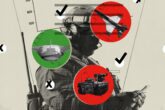August 12, 2025
The Dawn of Automated Warfare
This article was originally published on Foreign Affairs.
When Russia first launched its full-scale invasion of Ukraine, the conflict drew comparisons to wars of the twentieth century. Tanks, armored personnel carriers, and artillery dominated the battlefield, and both sides’ infantry were dug into trenches. We witnessed this old-school style of war when we made our first visit to Ukraine in September 2022. Since then, we have made regular trips to Ukraine, affording us firsthand insight into a monumental transformation: the beginning of a new kind of warfare.
In summer 2023, the commander of Ukraine’s Third Assault Brigade’s Drone Unit, whom we’ll call Fil (not his real name), told us that a new weapon had begun to change the conflict: first-person-view drones. These small, cheap, maneuverable quadcopters transmit real-time footage to their operators and detonate kamikaze-style on their targets. That year, Ukraine flooded the field with thousands of them and Russia soon followed suit. Today, hundreds of thousands of these drones fill the Ukrainian skies.
Drone-on-drone battle is now a central part of the war.
What began as a war with drones has become a war of drones. Indeed, two years ago, a Ukrainian brigade’s strength was judged mostly by its inventory of Western-supplied tanks, armored personnel carriers, and artillery. Since 2023, however, drones have become the most important weapon on the battlefield. Because of their low cost, speed, and precision, drones have now largely supplanted traditional weaponry, including antitank missiles, mortars, tanks, and even artillery and aircraft. Today, a unit’s power and resilience are dictated by its number of skilled drone operators and its ability to deploy drones at scale. (One of us, Schmidt, has been a longtime investor in defense technology companies, and is currently an investor in companies supplying drones to Ukraine.)
This represents a profound shift in warfare, largely instigated by Ukraine to compensate for its shortfalls in conventional weapons and manpower. In the world’s first drone war, drones determine how battles are won and how soldiers die: Ukrainian drone strikes now account for 90 percent of destroyed Russian tanks and armored vehicles and 80 percent of Russian casualties. They also have made it possible for each side to attack far past the frontlines without having to gain air superiority over the battlefield. Ukraine, for example, hit Russian airbases 5,000 miles from Kyiv in June by smuggling drones across the border and launching them from the beds of trucks.
Read the full article on Foreign Affairs.
More from CNAS
-
Defense / Indo-Pacific Security / Technology & National Security
To Compete with China on Military AI, U.S. Should Set the StandardsThe United States has an opportunity to lead in global norms and standards for military AI at a critical moment, when the foundations laid today could shape how militaries use...
By Jacob Stokes, Paul Scharre & Josh Wallin
-
The Pentagon Is Using Artificial Intelligence Right Now. Here’s How.
Artificial intelligence is the future of the military, or so Pentagon leaders keep saying. But is it the future — or is that future already here? That’s the question Breaking ...
By Josh Wallin
-
Countering the Swarm
After decades of air dominance and a near monopoly on precision strike, the United States now faces a dramatically different, more hostile world as the proliferation of cheap ...
By Stacie Pettyjohn & Molly Campbell
-
Defense / Technology & National Security
Safe and EffectiveThe promise of artificial intelligence (AI) and autonomy to change the character of war inches closer to reality...
By Josh Wallin




